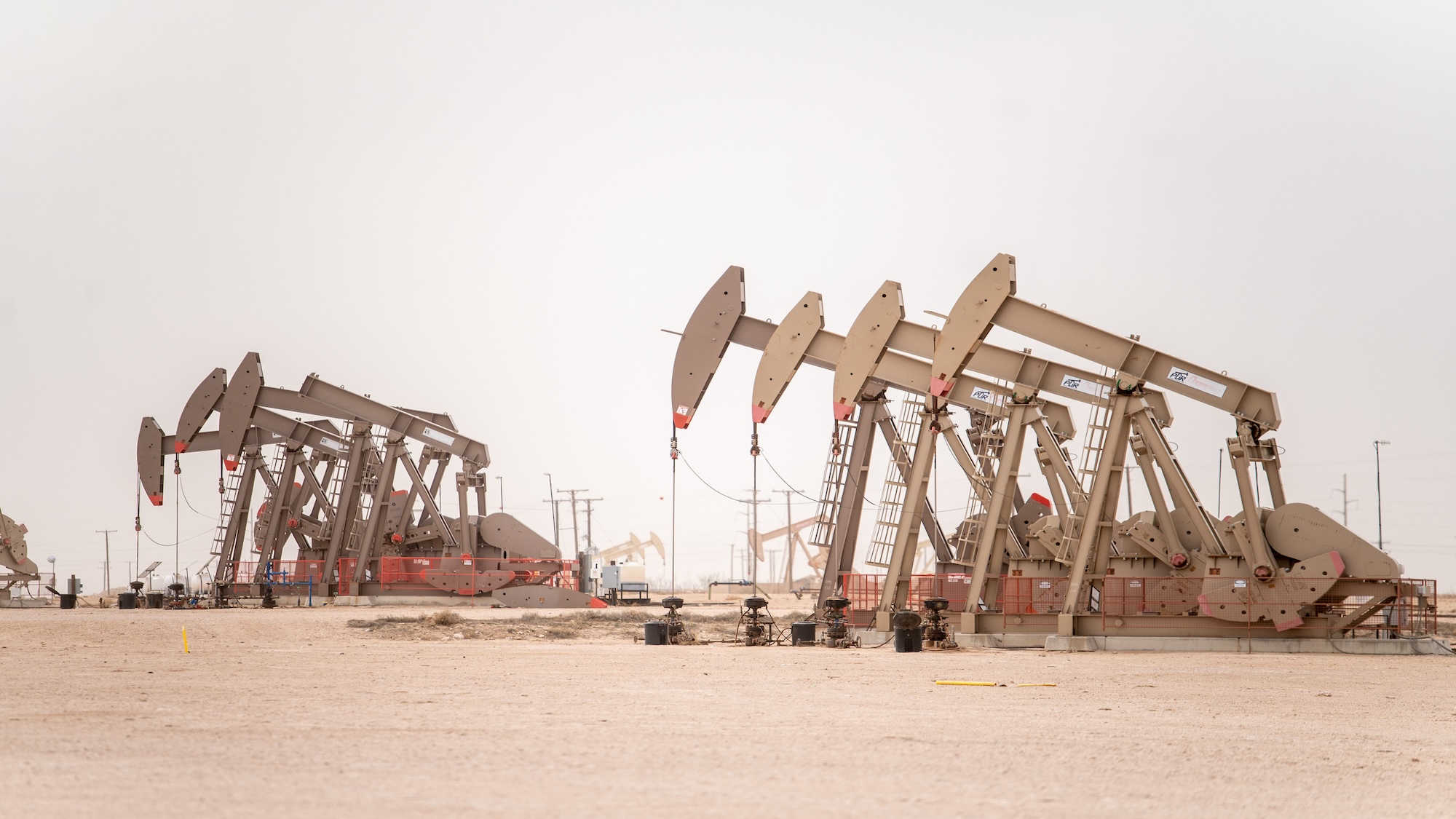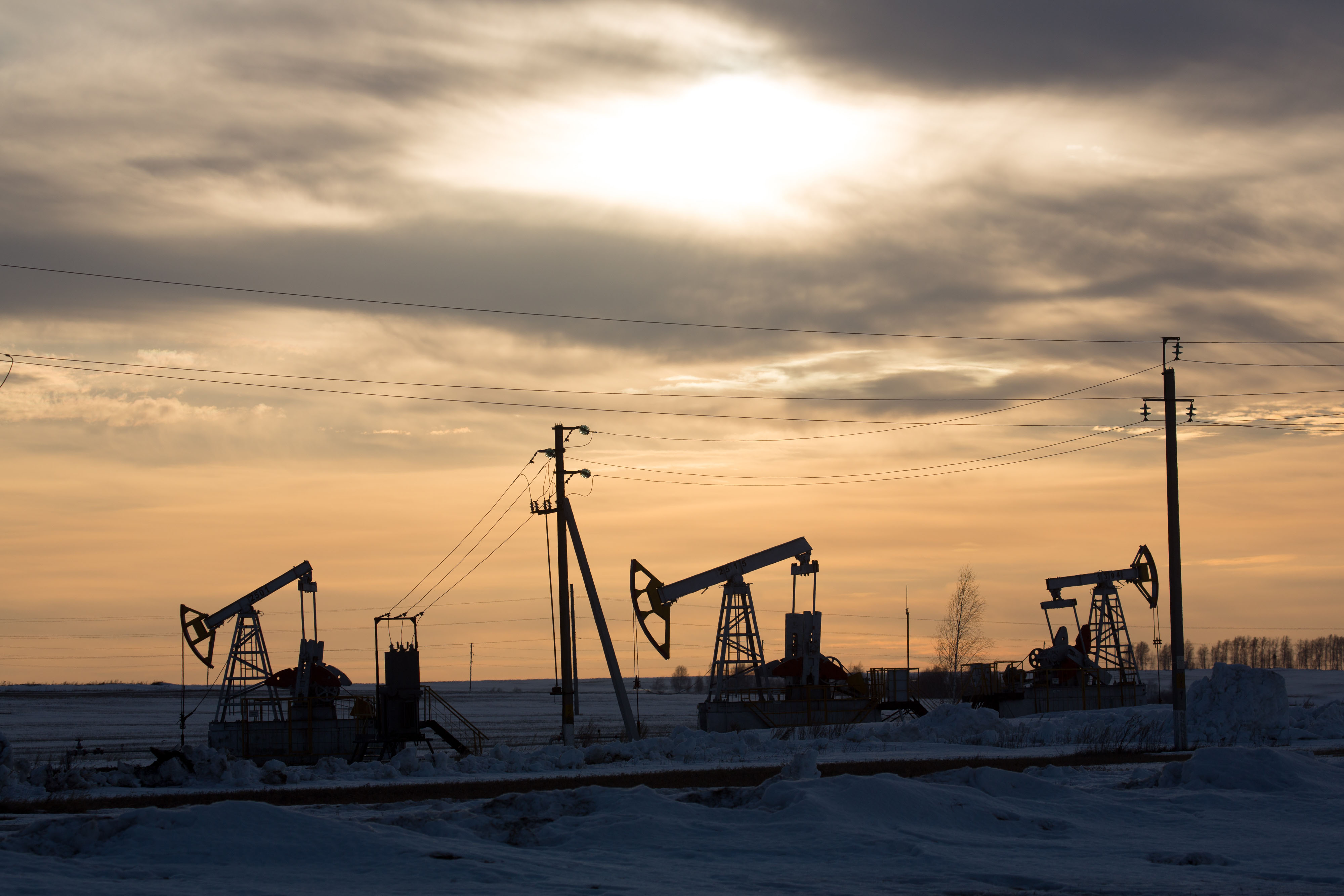Oil price posts two-year highs - but how long can it last?
Brent rose above $59 a barrel this week, its best third-quarter showing since 2004

Oil price: four reasons it could still fall to $20
18 December
Oil companies and countries dependent on revenues from 'black gold' might be forgiven for thinking that things cannot get much worse. Goldman Sachs, however, believes that they can.
Analysts at the US investment banking giant issued a note on Thursday in which they stood by the ultra-bearish forecast for global oil prices to slump to $20 a barrel next year, before recovering in any meaningful way, says CNBC. Here are four arguments supporting the case for another major drop:
The Week
Escape your echo chamber. Get the facts behind the news, plus analysis from multiple perspectives.

Sign up for The Week's Free Newsletters
From our morning news briefing to a weekly Good News Newsletter, get the best of The Week delivered directly to your inbox.
From our morning news briefing to a weekly Good News Newsletter, get the best of The Week delivered directly to your inbox.
1. Stockpiles just keep rising
Yesterday another report revealed that oil reserves were rising in the US – a bearish indicator for the ongoing global supply glut. The Wall Street Journal cites an estimate from data provider Genscape that stockpiles at the Cushing, Oklahoma depository, which acts as the delivery point for US benchmark West Texas Intermediate futures contracts, rose by 1.4 million barrels last week.
The rise mostly took place in the second half of the week and followed the US energy watchdog's report of a surprise surge of 4.8 million barrels in overall domestic crude oil reserves last week. In response, WTI fell to a six-year low of below $35 a barrel and international counterpart Brent crude fell close to one per cent to a new seven-year low of a fraction above $37.
2. Production is not falling enough
A free daily email with the biggest news stories of the day – and the best features from TheWeek.com
It is one of the enigmas that has confounded analysts: why production has remained resilient despite the painful fall in the oil price. US shale in particular, which is thought to be more expensive than much of the rest of global production, has fallen from its peak output of 9.6 million barrels a day but is still above nine millions barrels and has been edging higher of late.
Goldman Sachs says that with Opec already pumping 1.5 million barrels a day above a 30 million barrel production 'ceiling' – and having now abandoned any targets for production after its latest meeting ended in acrimony – there is simply not enough of a decline being signalled elsewhere to rebalance the market. This will not happen until the final three months of 2016, the bank reckons.
3. Fed rates rise will hit demand
Demand is also a key factor in the supply equation and, again, it has been disappointing. Efficiencies in fuel use, warmer weather caused by the El Nino phenomenon and a new drive to reduce fossil fuel burning to protect against climate change are all preventing drawdowns surging to meet or exceed supply.
The decision by the Federal Reserve this week could exacerbate this issue, traders fear. Lower oil prices were starting to filter through into greater fuel purchases, but if the dollar rises strongly on the back of the rates increase this will hold prices higher for overseas buyers and could undermine that trend.
4. Budget deal is bad news for Brent
For the international benchmark, Brent, there was further bad news this week in the form of a new budget deal in the US congress that controversially saw the Democrats cave in to Republican demands to remove a ban on domestic oil exports. The protectionist measure has meant that international oil is bought at a premium to the US benchmark and could see more oil flood onto the global market.
The net result of this could be that the 'spread' between the two prices shrinks – most likely through a fall in the relative premium paid for Brent. At some point this week the spread fell to less than $2 and some industry analysts reckon that over time the two prices may even reach parity.
Are any rises being predicted?
Plenty, in fact the consensus view probably still remains for oil to enjoy higher average prices in 2016 than this year. But these forecasts are falling every time they are republished and many experts are now predicting a near-time fall lower – perhaps to around $30 a barrel – before a volatile recovery pushes prices to within a wide $40-$60 range.
Oil price hits another low after 'dead cat bounce'
17 December
Chris Jarvis, president and senior analyst at Caprock Risk Management in Maryland, struck a sombre note when he spoke to CNBC. "I don't view the… statement as being all that supportive and now that we have the announcement behind us, it's back to fundamentals," he said.
In the second instance, Jarvis was commenting on the ongoing oversupply situation, which Bob Yawger, director of the futures division at Mizuho Securities USA, told the Wall Street Journal was "negative with an exclamation point". New data from the US energy watchdog yesterday showed that domestic stockpiles surged by 4.8 million barrels last week to a new all-time record of above 1.3 billion barrels. Analysts had expected a slight fall.
The result of all this was that the two-day rally in the oil price from its post-crisis low was revealed to be, in the words of FastFT, nothing more than a "dead-cat bounce". Having risen to above $38 a barrel – which is still unprofitable for much global production – international benchmark Brent crude fell by three per cent to a little above $37 a barrel.
This represents a new low since December 2008 and is only marginally above the next lowest point in July 2004. Earlier that year the oil price had been below $30 a barrel and some experts reckon it will return to a similarly low price in the early part of next year as Iranian exports open up after the removal of international sanctions.
Reuters says a number of factors could exacerbate, or reverse, this trend. It highlights the continued and unexpected resilience of expensive US shale production, and Opec's current disarray, as bearish indicators; but also points to unrest in the Middle East, a likely increase in demand and the potential for further investment cuts as factors that could give bullish traders "a reason to pile back in".
Overall, most industry analysts agree that it will take time to reverse the huge supply overhang so that prices can recover significantly. Only a major concerted effort on supply is likely to make this happen before the end of the next year.
Oil price: who is betting on a recovery in 2016?
16 December
The oil price has been in recovery in recent days. Having hit a post-crisis low of close to $36 a barrel on Monday, it has since rallied and at one point yesterday it was back above $38 a barrel.
But this is still a painfully low price, close to 70 per cent below the September 2014 peak. While unprecedented production efficiency has protected drilling companies in a way few thought possible, in the North Sea, for example, it is still supposed to cost approaching $50 to extract a barrel of oil. This should be significantly higher in US shale oil fields.
The situation is worse for those countries that depend on oil as a source of income. Many Opec members in financial difficulty, such as Venezuela and Nigeria, the de facto cartel leader Saudi Arabia and even non-Opec export giant Russia, all designed budgets around oil prices in excess of $100 a barrel.
As investment is rapidly withdrawn and spending cut, these companies and countries are hoping prices will recover more quickly than markets currently expect. Encouragingly for them, there are experts who see that happening.
Liam Halligan wrote in the Daily Telegraph this week that prices will recover faster, as investment cuts are ramped up to cope with the latest price crash. Elsewhere, The Times reports that the Wellcome Trust has substantially increased its investment in energy stocks such as Shell and BP as it "builds into what markets are doing" and takes advantage of perceived bargains ahead of an inevitable recovery.
Reuters says that there is also a wider market bet gaining traction for prices to recover to between $50 and $80 in 2016, with derivatives that would pay out in this range climbing "steeply" in recent weeks.
The downside is that investors broadly see this happening in around 12 months at the very end of 2016. Near-term bets are still on further falls, perhaps to around $30 in the early months of next year as Iranian exports re-emerge from behind international sanctions.
It will take an output concession from Opec to push the price higher sooner – and the group has seldom looked less cohesive on its production policy.
Oil price misses 11-year low – but for how long?
15 December
The oil price recovered in afternoon trading in New York yesterday, after coming close to 11-year lows earlier in the session.
International benchmark Brent crude had earlier tumbled below $37 a barrel in London and settled just 13 cents above the $38.20 it reached in September 2008 in the teeth of the global financial crisis.
Below this, it would be at the lowest level since July 2004, Reuters notes, when it briefly languished in the mid-$30 range after a protracted recovery from a single-digit mid-1990s trough.
The rally yesterday, during which Brent bounced back two per cent, was not driven by particular fundamentals.
Rather, it was a function of inevitable volatility in a market that is currently beset by 'short' bets on a lower price. This morning Brent was sitting a little above $38 a barrel, which is still unprofitable for most production.
'Long' positions – bets on a higher price – are now at the lowest since records were first compiled in 2009.
This means two things: there will probably be some wild swings, as 'short positions' are rapidly covered any time the price ticks upwards even slightly; and most traders and analysts are still convinced the market has not found its bottom.
Where could that bottom be? A technical analysis has been offered by legendary data trader Daryl Guppy, who writes on CNBC that current trend charts indicate "prices have further to fall".
Based on historical support levels and general trading patterns, he sets a main target for the price floor at a little below $30 a barrel, near that 2004 nadir.
There is a consensus fast emerging that a price around this level will be reached before the supply glut clears next year - but there are those who believe if this does happen it will presage a faster recovery than some are currently expecting.
Echoing the Shell chief executive Ben van Beurden, who warned in October that rapid retrenchment could cause oil prices to spike, Nick Cunningham writes on Oilprice.com that another big step down in prices could "spark deeper cuts to spending and drilling, which could perhaps contribute to an accelerated pace of adjustment".
-
 Tea with Judi Dench: ‘touching’ show is must-watch Christmas TV
Tea with Judi Dench: ‘touching’ show is must-watch Christmas TVThe Week Recommends The national treasure sits down with Kenneth Branagh at her country home for a heartwarming ‘natter’
-
 Codeword: December 24, 2025
Codeword: December 24, 2025The daily codeword puzzle from The Week
-
 Sudoku hard: December 24, 2025
Sudoku hard: December 24, 2025The daily hard sudoku puzzle from The Week
-
 How might the Israel-Hamas war affect the global economy?
How might the Israel-Hamas war affect the global economy?Today's Big Question Regional escalation could send oil prices and inflation sky-high, sparking a worldwide recession
-
 Recent mega-mergers could signal a turning point for the US oil industry
Recent mega-mergers could signal a turning point for the US oil industryTalking Point Both Chevron and Exxon have recently spent billions to acquire smaller oil companies
-
 Has Saudi Arabia lost control of oil prices?
Has Saudi Arabia lost control of oil prices?Today's Big Question Kingdom goes it alone to cut production, risking tension with US and reigniting cooling inflation in Europe
-
 US angered by Opec+ oil cut
US angered by Opec+ oil cutSpeed Read Energy prices to rise further as producers slash supply by two million barrels a day
-
 Global oil demand forecast lowered for 2020 and 2021
Global oil demand forecast lowered for 2020 and 2021Speed Read IEA report says jet fuel demand remains the major source of weakness
-
 Are US-Iran tensions flaring again?
Are US-Iran tensions flaring again?In Depth Trump threatens military action over Twitter
-
 Can a deal be struck to raise oil prices?
Can a deal be struck to raise oil prices?In Depth Opec+ will convene today over video link in a bid to boost crude
-
 What do negative oil prices mean?
What do negative oil prices mean?In Depth Perfect storm of oversupply and storage shortages sees producers paying to get rid of US crude